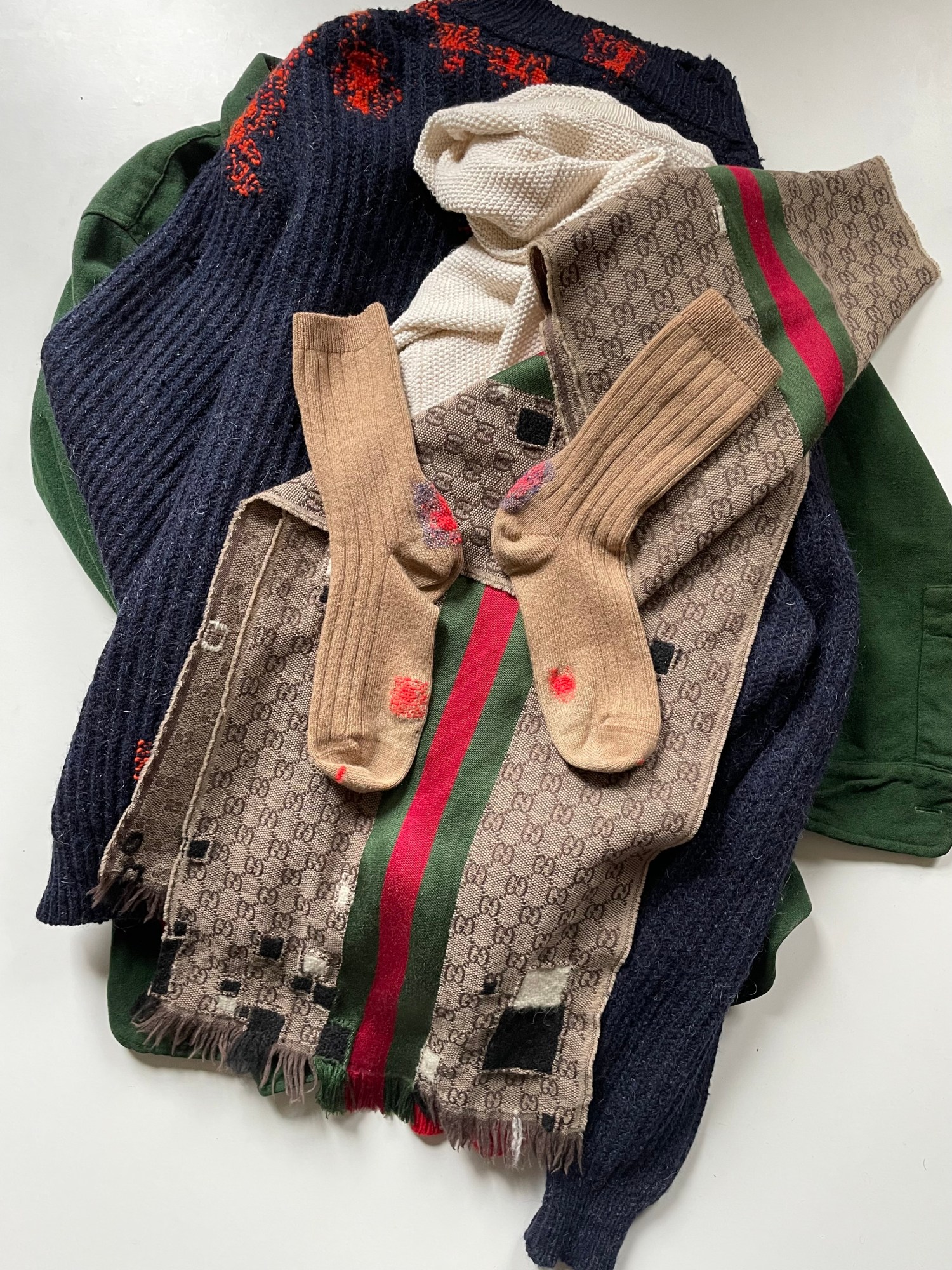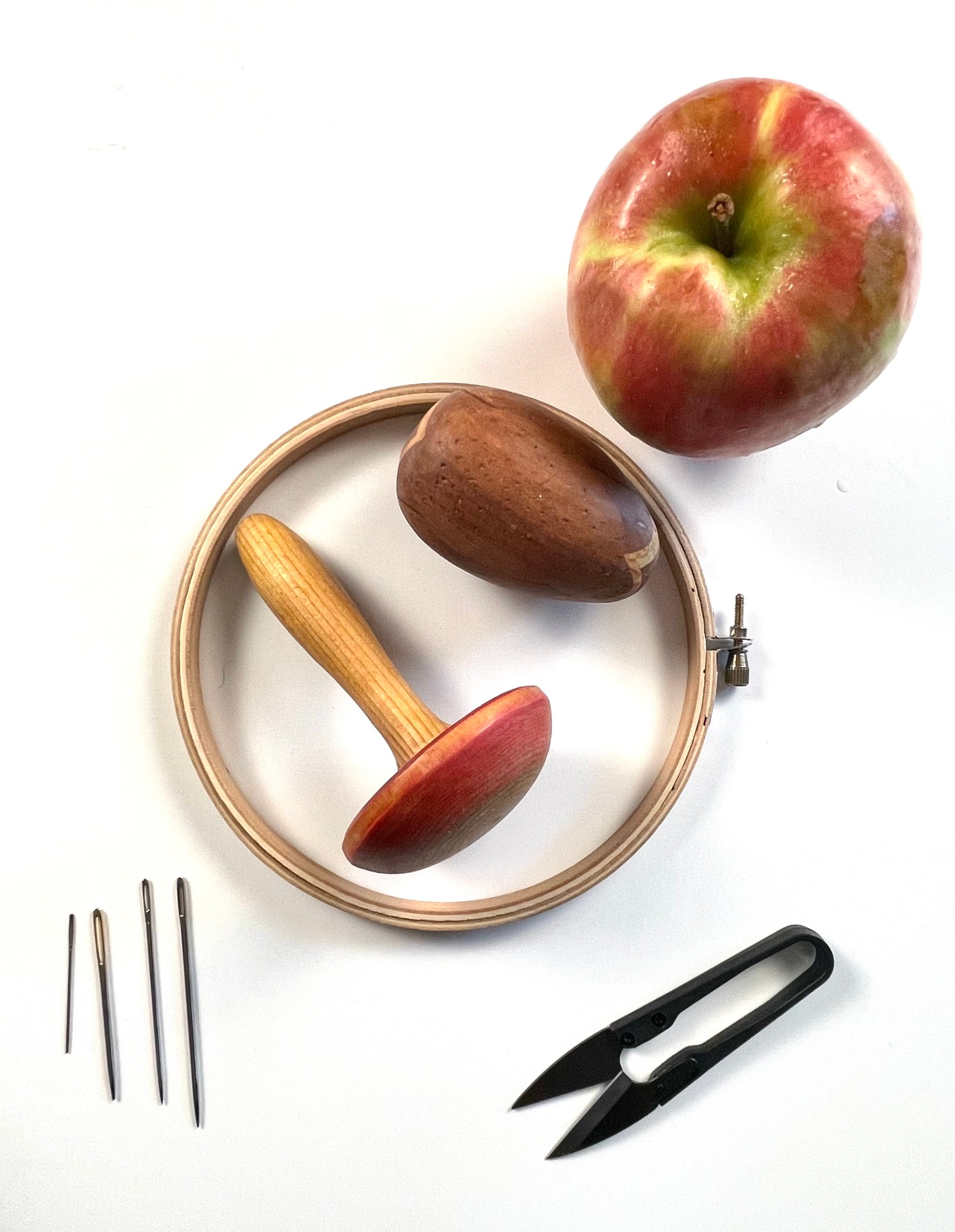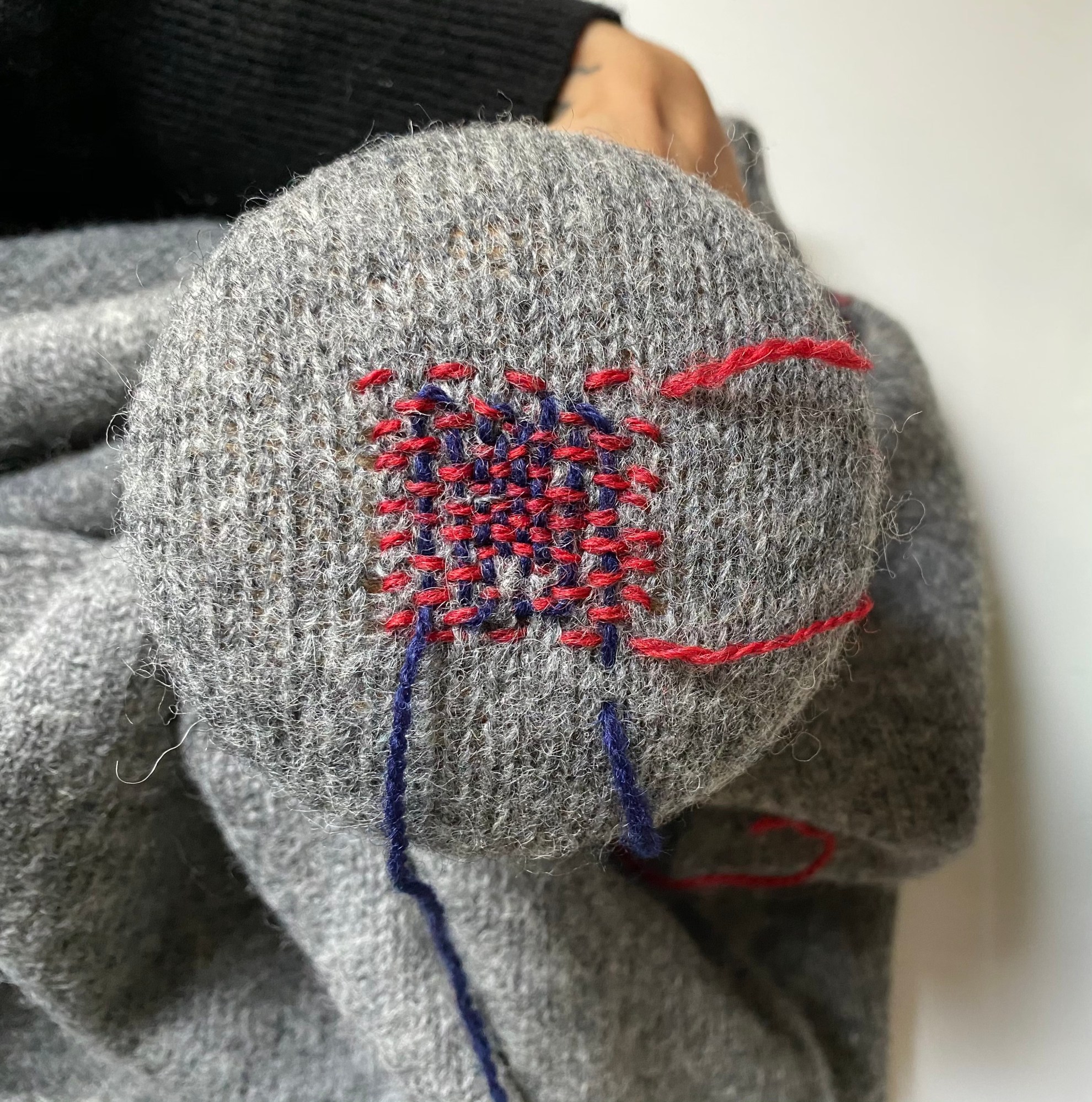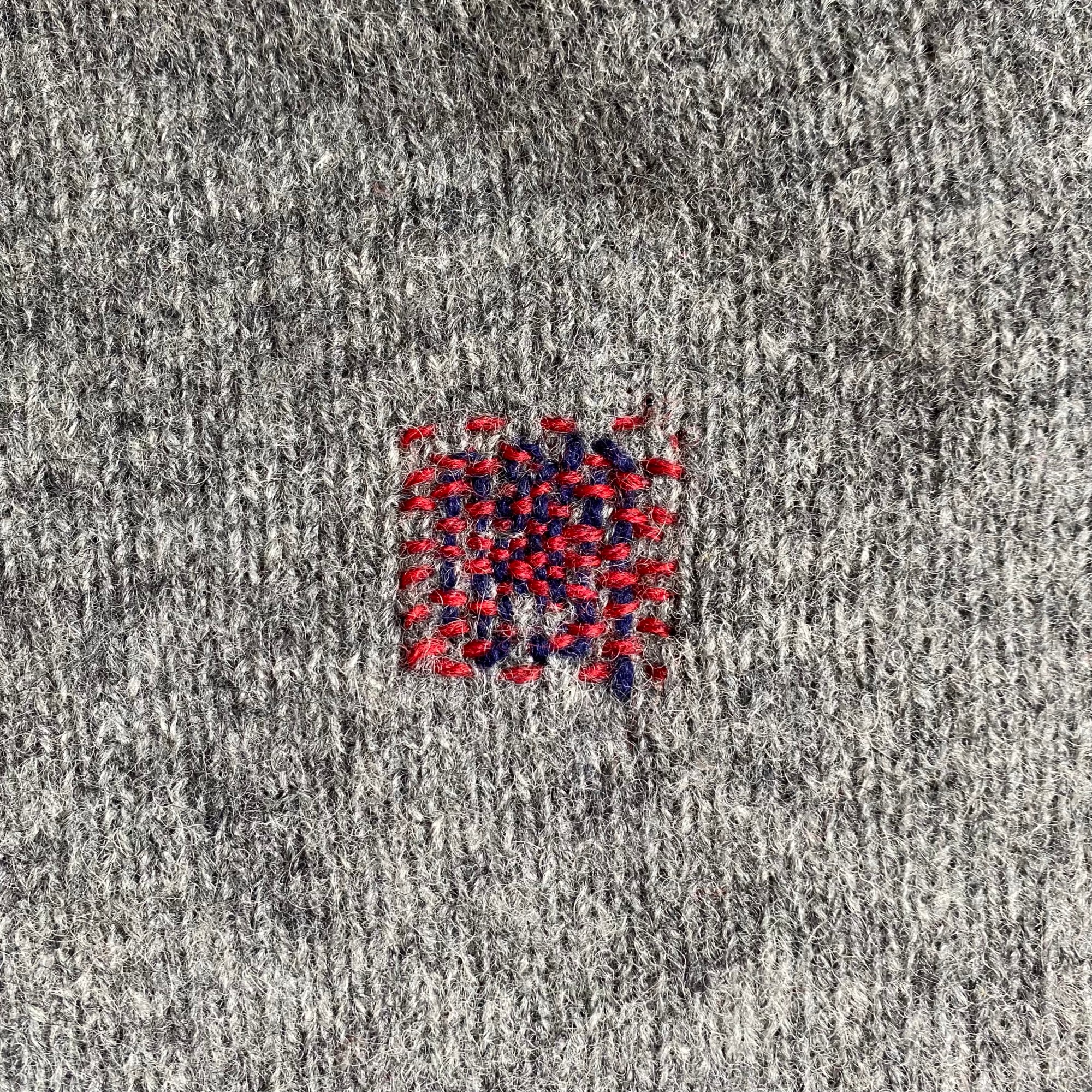A lot of brands are bringing elements of sustainability into their production. But continuing to buy new fashion, even if you choose to buy from brands trying to create in more sustainable ways, is fundamentally unsustainable. We have to make less, buy less, repair much more. Darning is a simple way to extend the life of clothing, and even another nine months of wear can make a significant decrease in the environmental damage caused during production of a piece.
Rachel Meade Smith, an editor, writer and self-taught textile artist, and Sam Bennett, a design educator and material researcher with a background in textile design, are darners sharing their skills through Repair Shop. Together they restore knitwear through commissions, as well as teaching others how to darn through in-person and online workshops. They gave us a lesson in visible mending while we discussed their approach to buying, the mindset shift needed in valuing repair, and finding some zen while darning.
What’s your approach to sustainability and how did it factor into your darning work?
Rachel Meade Smith: I have always been someone who’s bought mostly second-hand, in a kind of non-reflective way. It was just the approach I took to my own personal consumption of clothing and materials. And as I went to grad school and studied critical design, research and design history, I started looking more at sustainability and circularity and critical approaches to our own participation in production and consumption. I started to pay attention to what happens when you throw something away. Because the relationship doesn’t stop once you purchase it, there’s larger ripples, a life-cycle that you are now part of.
When I started doing textiles about six years ago, it became more intense, and I was making and making and making all the time. I started to have that same kind of questioning and feelings that I was having with clothing, which is, okay, I made this stuff, I bought all this yarn, I bought all these materials, and really, I’m just doing this because I enjoy making. But what do I do with this thing later? Do I sell it? Do I put it in a drawer? Do I throw it away? I started having these questions about the responsibility of being a person who makes, even on a small scale, and what a practice would look like that didn’t create something new, but instead worked with existing materials. So, when I started learning how to darn, I realised that there was this whole part of the process that I no longer had to struggle with, which was — what do I do with this thing now? Because I’d be fixing a sweater, and then I would give it to them. And that would be the exchange. When I’m working on repair, I’m actually part of an existing process, I’m not bringing forth any additional burden to the planet or society. That’s one of the things that I love about this practice.
That makes a lot of sense. We’re so often talking about sustainable fashion, but it feels incompatible to be creating newer and more. It just has to come back to reusing and repurposing and repairing. What’s your personal stance on sustainable consumption?
Sam Bennett: I’m from Kansas and moving to New York was quite a feat for me personally, and getting a job in the textile world, I was just super excited about it. But then I realised that I was essentially designing for a landfill. It was incredibly depressing. That had been a reason why I wanted to shift into interiors, thinking, well, I’m going to be designing more for people — but it’s the exact same problem in a different industry. So, on the eve of 2020, I was like, I’m going to make a new rule for myself — that I can’t buy anything unless I know exactly how it’s made and where it came from. And if I couldn’t figure that out then I had to work out how to make it myself. I’m not a big consumer anyway, it’s just been part of my way for years now. And then the pandemic happened three months later, so it was kind of perfect.
I knew Rachel was already starting to darn, and so she taught me how to too. Although I already know how to embroider and bead, it was really nice to sit next to her and have her show me her methods. Once I learned, I started repairing a lot of clothes. It’s so therapeutic to be able to fix something, it’s really magical, you feel empowered, and the act of darning, I think too, is meditative.
So, you find it a really relaxing practice?
S: Yeah, I’ve been so busy these last months with school starting back up. And it’s really been rare for me to be able to darn and I can like feel it in my body. Like, I just want to sit and stare at something and fix it.
R: It’s so amazing the way the time passes. I’ll be like, oh I’ve been darning for 35 minutes, and then I’ll look at the clock and three hours have passed. I feel this looseness in my body that tells me that my brain has sort of gone to another plane. And I think it’s because you’re so focused on this teeny tiny scale. It’s just this incredible way to both disconnect and reconnect elsewhere to something very material. And for people like me who are just constantly overthinking like 10,000 thoughts a second, it’s a very calming act.

Rachel, you’re self-taught – how did you learn darning?
R: I feel like I learned about darning late. I was at a basket weaving retreat (laughs), in 2019 — all these fibre textile nerds together — and I heard about Celia Pym, who is the queen of darning, of visible mending. I think I just found a pair of socks and an apple, because you can use an apple to hold tension, and I just gave it a shot. I was already a weaver, so darning is essentially weaving on a small scale. I think I picked it up pretty quickly because I could understand tension and density and that sort of thing. I remember being really pleased with my first darn, a pair of socks with big holes in the heels, and I was like, dang, those look pretty good. I really just looked at a lot of photos, and I practised, and I did not stop darning after that. What I’ve learned through all of my textile explorations is that if you just keep doing it over and over with different materials at different scales, you will figure it out. And the more you do within the textile crafts domain, you develop a sensibility for fibre, that translates across them.
How long does it take to get good at?
R: Some people can do a great darn on their first try. For others, it may take more like a month of regular practice. If you have experience with textiles, like if you’re already a weaver, or a knitter, I think after a couple weeks you’ll feel good.
I know you do commissions for other people — how did that start and what has it taught you about how people value repair?
R: The thing about visible mending is it’s an advertisement basically. It’s like, oh that’s amazing, I have a hole in my sweater, can you do that for me? And I always want to be like, you can do it. It’s really easy. But at a certain point people were asking, will you do it, I will pay you.
It’s an interesting service to sell, because there is not a high value placed on repair in general. I just got two pairs of shoes repaired, two of my favourite pairs of boots. One was completely broken; the heel had come off, and the repair guy told me that the entire sole was broken too. And he fixed them for $45. That is mind-blowing. When you think about all of the expert knowledge, the years he put into developing that skill and all of this machinery that he uses to fix it. Like, yes, absolutely I will pay that. With darning, what someone is willing to pay is totally dependent on the person and what they understand about the time required, the process of developing craft knowledge. So, it’s hard to price, you never know what someone’s gonna say. We also don’t want to price anyone out of repair. That’s part of why teaching the skill to others is so important to us.

That’s a really important aspect in the conversation of this kind of sustainable practice, the mentality about what value to place on repair work. And that’s obviously something that’s going to need to shift massively.
S: Yes. And just thinking about attachment to things. So, sentimentality sometimes plays in with the price. People might be more willing because it was their grandfather’s sweater, versus oh, I just like bought the sweater, it didn’t cost that much. Like, why would I pay you when I could just buy another one?
As part of your darning workshops you go into some of the history of darning, can you talk a bit about that?
S: We do a kind of a brief lecture that we both think is important. We put darning in the context of mending across the world and across centuries, and then really show the difference between visible and invisible mending and how that correlates with trends of sustainability and fast fashion. It’s part-history lesson and then part-where we are today, how in the United States in particular, textile consumption has quadrupled since the 1980s.
R: In addition to [pointing out] the fact that darning and other visible mending is not new, we like to put into context the fact that it originated out of poverty. People needed to mend, every young girl learned how to mend because it was very expensive to buy new clothes, it was not really an option.
The same with boro in Japan, that originated because poor farm families couldn’t afford to buy new textiles so they would patch together all of these scraps to be a new blanket or a new coat or something. These practises that we do now because we have the time and we can find the knowledge online or wherever, that’s kind of our privilege now, that we get to engage in this practice.
S: Yeah, it is so time consuming that it really is such a privilege, spending three hours on a few holes that will ultimately bring a garment back to life.
Visit Repair Shop to find out about upcoming classes.



